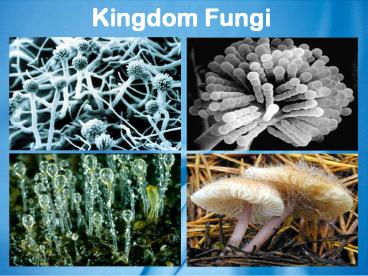Kingdom Fungi - PowerPoint PPT Presentation
Title:
Kingdom Fungi
Description:
Kingdom Fungi * Importance of Kingdom Fungi 1. many pathogenic species ex. Ringworm ex. athlete s foot ex. potato blight 2. decomposers i.e. saprophytes recycle ... – PowerPoint PPT presentation
Number of Views:401
Avg rating:3.0/5.0
Title: Kingdom Fungi
1
Kingdom Fungi
2
Importance of Kingdom Fungi
- 1. many pathogenic species
- ex. Ringworm
- ex. athletes foot
- ex. potato blight
- 2. decomposers
- i.e. saprophytes
- recycle dead organisms
- (fertilize soil)
- break down toxic waste
3
Importance of Kingdom Fungi
- 3. some species produce antibiotics
- ex. Penicillium
- 4. food source
- mushrooms (vitamin D)
- make blue cheeses
- 5. yeast used commercially to make
- bread
- beer wine
edible mushrooms
chicken of the woods
beefsteak
4
Similarities Between Plants Fungi
Plants Fungi
- eukaryotic cells
- numerous organelles
- multicellular (except yeast)
- have cell walls
- anchored in soil
- stationary
- reproduce asexually or sexually
5
Differences Between Plants Fungi
Plants Fungi
one nucleus per cell many nuclei per cell
autotrophs heterotrophs
have roots no roots
cellulose in cell walls chitin in cell walls (like insects)
reproduce by seeds no seeds
6
Generalized Structure
nuclei
- made of thin filaments called hyphae
cell wall
7
Generalized Structure
- mycelium formed by many intertwined hyphae
- i.e. colony
- usually forms on or below surface of soil
mycelium showing many interlocking hyphae
8
Life Cycle Asexual Reproduction
- spores
- unicellular reproductive cells (ie. made of one
cell) - formed in specialized spore cases called
sporangia (um) - when mature, sporangia break open releasing
1000s of spores to be carried by the wind
Sporangiophore
- each spore forms a new mycelium (identical to
parent) - ex. Rhizopus stoloniferous- bread mould
9
Life Cycle Sexual Reproduction
- 2 nuclei in specialized hyphae fuse
- grow into a mushroom (fruiting body)
- sexually produced spores form on the inside of
the gills
- as spores mature, mushroom opens up releases
its spores to the wind - (up to 2 billion/mushroom)
- each spore grows into a genetically different
mycelium
10
Life Cycle Sexual Reproduction
cap
Label the following diagram of a mushroom.
gills
stalk
October 11, 2020
11
Yeast
- different from other fungi because
- unicellular
- reproduce asexually by budding
1. nucleus doubles
2. one nucleus moves into the bud
3. bud grows falls off to become a new
yeast cell identical to parent
12
Homework
- Page 140 1, 3, 5, 6, 8































